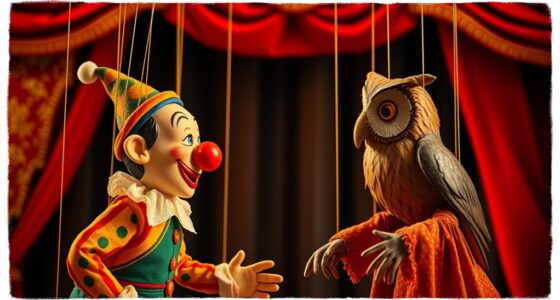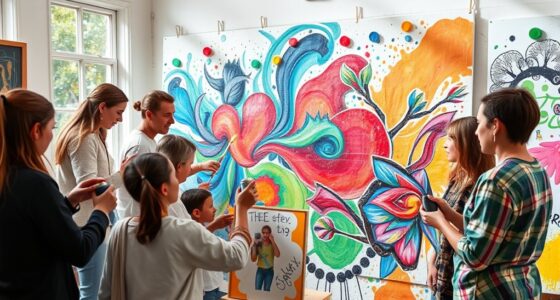When you incorporate music into play, you naturally connect your body to the rhythm through instinctive movement like tapping or swaying. Playing instruments or improvising dance helps deepen this bond, making you more aware of timing and expression. Moving spontaneously to music transforms passive listening into lively, personal activity. If you keep exploring these practices, you’ll discover how rhythm can become a powerful, fun part of your playful experiences.
Key Takeaways
- Use musical instruments like drums or shakers to deepen rhythmic awareness through hands-on exploration.
- Encourage spontaneous dance improvisation to connect movement naturally with musical rhythms.
- Incorporate rhythmic play activities that promote active participation and emotional expression.
- Integrate music therapy techniques to strengthen the link between rhythm, movement, and emotional well-being.
- Foster an environment where movement responds instinctively to musical cues, enhancing creativity and physical engagement.

Have you ever noticed how music naturally makes you want to move? It’s like an invisible force pulling you into a rhythm that feels both instinctive and exciting. When you listen to different sounds, your body responds in ways you might not even realize—tapping your foot, swaying your hips, or even jumping around. This isn’t just happenstance; it’s a powerful connection between music and movement that you can actively explore through instrumental exploration and dance improvisation. These practices allow you to deepen your understanding of rhythm and express yourself more freely through movement. Incorporating music therapy techniques can further enhance this connection and promote emotional well-being. Instrumental exploration is a fantastic way to connect with music on a personal level. When you pick up an instrument—whether it’s a drum, a guitar, or even a simple shaker—you begin to understand the intricacies of rhythm firsthand. Playing an instrument forces you to feel the beat, develop timing, and experiment with different sounds. As you experiment, you’ll notice how your body naturally syncs with the music, creating a more visceral connection. This process isn’t about perfection; it’s about discovering what feels good and what makes your body want to move. The more you explore different instruments, the more your awareness of rhythm grows, and your ability to incorporate that into movement improves. Dance improvisation takes this concept even further. When you allow yourself to move spontaneously to music, you open the door to creative expression. You don’t have to follow a set routine or choreography—just let the music guide your body. This kind of improvisation encourages you to listen deeply to the rhythm, accents, and subtle changes within the music. As you respond instinctively, you’ll notice your movements becoming more fluid, natural, and unique. It’s a freeing experience that bridges the gap between listening and doing, turning passive enjoyment into active participation. Dance improvisation helps you develop a stronger sense of timing and personal style, making movement an extension of your emotional response to music.
Frequently Asked Questions
How Does Rhythm Benefit Early Childhood Development?
Rhythm benefits early childhood development by boosting brain development and supporting emotional regulation. When you encourage children to engage with rhythmic activities, they enhance neural connections, improving their cognitive skills. Additionally, rhythm helps children manage their emotions, teaching them patience and self-control. By incorporating rhythm into play, you give children a fun way to develop essential skills, making their growth more balanced and emotionally resilient.
What Are Some Age-Appropriate Musical Activities for Toddlers?
Ever wondered how to make music fun and educational for toddlers? You can try age-appropriate musical storytelling, where kids listen and participate, or sensory musical games that engage their senses. These activities develop listening skills, coordination, and language. Are you ready to see how music sparks creativity and joy in your little one? Incorporate simple instruments, singing, and movement to create engaging, developmentally beneficial experiences for your toddler.
Can Music and Movement Improve Social Skills in Children?
Yes, music and movement can boost your child’s social skills. When they participate in group dancing, they learn cooperation and sharing. Musical storytelling encourages listening and turn-taking, helping them connect with peers. These activities foster a sense of belonging and improve communication. By engaging in rhythm-based play, your child develops empathy and emotional understanding, making social interactions more enjoyable and meaningful.
How Can Parents Incorporate Rhythm Into Daily Routines?
You can incorporate rhythm into daily routines by engaging your child in fun activities like clapping games and dance routines. These activities help develop their sense of timing and coordination while making everyday moments enjoyable. During car rides or chores, suggest simple claps or dance moves to the beat of music. This encourages your child to actively participate, fostering a natural love for rhythm and movement.
Are There Recommended Instruments for Young Children to Explore Rhythm?
Did you know that children’s early exposure to music can boost brain development? For exploring rhythm, start with simple instrument options like tambourines, maracas, or small drums—great beginner percussion choices. These instruments are easy to handle and encourage your child’s natural sense of timing. By introducing these, you help them develop coordination, listening skills, and a love for music—all while having fun together.
Conclusion
Think of yourself as a gardener, planting seeds of rhythm and movement in your child’s world. As you nurture these seeds with music and active play, they grow into vibrant, dance-like flowers that brighten every corner of their day. When you embrace music and movement together, you cultivate a joyful garden where creativity blossoms and confidence flourishes. So, keep dancing and singing—your child’s beautiful, lively landscape is just waiting to bloom.










